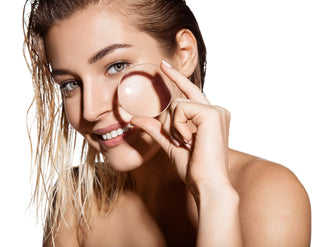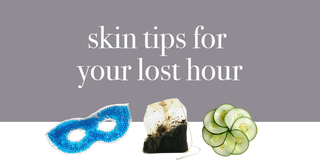Beauty sleep is real. We have some knowledge of how sleep can affect our body, but how does it affect our skin?
The answer lies with circadian rhythms, or the 24-hour cycle that impacts our daily routines and our body's physiological rhythm. Studies on skin cell division and regeneration have discovered that the cells in our epidermis are most active after midnight, but there's more to this rhythm and our sleep cycle that affects our skin. Using the right combination of products at night and practicing a few small lifestyle habits before bed can help contribute to a more rejuvenated look to your skin in the morning.
Use Your Exfoliants at Night
At night, when your cells are at their max-rate of regeneration, glycolic and retinol are your go-to ingredients to help boost rejuvenation. Alternating your retinol serum and glycolic serum at night delivers a beneficial balance of regeneration and exfoliation. Together, they address tone and texture, diminish the appearance of lines and wrinkles, brighten discolorations, and inhibit acne formation. Retinol and glycolic products are recommended at night because they are notorious for increasing sun sensitivity, and retinol can be degraded by UV, making it less efficient. Always apply sunscreen in the morning when using these products.
Combat Tired-Looking Skin
Getting a good night's rest helps regulate inflammation and cortisol in the body. Without good sleep, both increase and adversely affect our body and skin. Tired skin looks lackluster and dehydrated, the face looks puffy, and under eye puffiness and dark circles are more prevalent. To combat signs of fatigue, a gentle five-minute facial massage with your favorite moisturizer or hyaluronic acid serum can help promote lymphatic drainage and blood circulation that contours and brightens your face (if you have an ultrasonic or high frequency device, this is the perfect time to use it).
RECOMMENDED PRODUCTS
Reduce Under-Eye Circles and Puffiness
Specially formulated eye creams are excellent at helping to reduce dark circles and puffiness, but sometimes they need a little help maximizing their benefits. Skin around the eyes is 10x thinner than our face and is more susceptible to vascular damage in the form of dark circles. Chronic sinus pressure from allergies paired with poor circulation and inflammation from lack of sleep can make dark circles more prevalent. Brightening Eye Complex contains high potency tumeric extracts that target inflammation and vascular damage, and light-reflecting minerals that immediately brighten dark circles.
Fatigue-driven puffiness looks like a slight swelling all around the eyes (if your puffiness is only visible under your eyes or under-eye bags, these are fat pads that have shifted or moved and can be corrected by a plastic surgeon). If you enjoy hot green tea, apply your seeped green tea bags to your eyes as a compress to help reduce puffiness.
Time changes and seasonal changes may throw a wrench in your circadian sleep rhythm, but with a few skin hacks and the right combination of products, you'll look like you never missed a wink.
M. Irwin, MD, M. Wang, MSN, C. Campomayor, MS. Sleep Deprivation and Activation of Morning Levels of Cellular and Genomic Markers of Inflammation. Arch Intern Med. 2006; 166(16): 1756-1762.
R. Leproult, G. Copinschi, O. Buxton, E. Van Cauter. Sleep Loss Results in an Elevation of Cortisol Levels the Next Evening. Sleep. 1997; 20(10): 865-870.
V. Kumar, B. Andersen, J. Takahashi. Epidermal Stem Cells Ride the Circadian Wave. Genome Biol. 2013; 14(11): 140.



